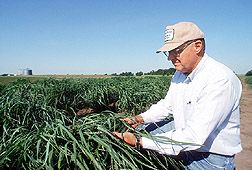 Most people never heard the word “switchgrass” before it was immortalized by President Bush in his State of the Union address, but someday we could be running our cars on fuel made from the stuff. USDA’s Agricultural Research Service just released a new study on the feasibility of switchgrass for energy production, focusing specifically on the economics of growing the crop and how to get the most yield per acre. According to an ARS report, “two switchgrass plants per square foot the first year ensures a successful bioenergy crop harvest in subsequent years.” The studies were done on farms in Nebraska, South Dakota and North Dakota, since switchgrass is a native prarie grass in those states. Normally the grass is used for conservation purposes or cattle feed. The guy in the picture is Ken Vogel, a geneticist at the ARS Grain, Forage and Bioenergy Research Unit at Lincoln, Neb. who led the study. Here’s a link to the report on “Establishment Stand Thresholds” reported in the January issue of Crop Science magazine, if you’re into that.
Most people never heard the word “switchgrass” before it was immortalized by President Bush in his State of the Union address, but someday we could be running our cars on fuel made from the stuff. USDA’s Agricultural Research Service just released a new study on the feasibility of switchgrass for energy production, focusing specifically on the economics of growing the crop and how to get the most yield per acre. According to an ARS report, “two switchgrass plants per square foot the first year ensures a successful bioenergy crop harvest in subsequent years.” The studies were done on farms in Nebraska, South Dakota and North Dakota, since switchgrass is a native prarie grass in those states. Normally the grass is used for conservation purposes or cattle feed. The guy in the picture is Ken Vogel, a geneticist at the ARS Grain, Forage and Bioenergy Research Unit at Lincoln, Neb. who led the study. Here’s a link to the report on “Establishment Stand Thresholds” reported in the January issue of Crop Science magazine, if you’re into that.
A big plus for switchgrass is that as a perennial plant, switchgrass has the advantage of not needing annual planting and tillage. Skipping these can save soil and energy. It can also reduce sediment and other pollutant losses to waterways.
By the way, research into switchgrass for energy production has been going on for at least a decade. I know that because I remember doing a story about it when I still worked at Brownfield Network – and I left there in 1997!

